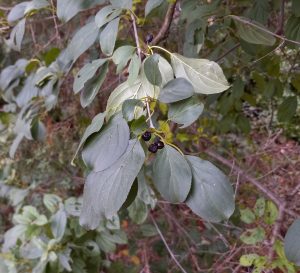
European Buckthorn (Rhamnus cathartica)
European Buckthorn was initially introduced to Ontario in the late 1800s. Used as a hedgerow species to block wind and reduce erosion, it quickly spread throughout the province. European Buckthorn spreads quickly through their berries, which are eaten by birds and mammals. These berries have a laxative effect, which helps in their spread. European Buckthorn seedlings (along with many other invasive species) can often be found sprouting under perching sites popular with songbirds, such as large conifer trees.
This species ranges in size from shrub to small tree, with thorn-like tips on stems and black berries in dense clusters along stems. Like most invasive species, Buckthorn leafs out very early in spring, and retains its leaves late into the fall.
When European Buckthorn takes over an area, it changes the nitrogen composition of the soil to restrict the growth of other species. This effect persists even after all Buckthorn in the area is removed. Like all invasive species, European Buckthorn reduces species diversity in any area it occupies and facilitates the spread of other invasive species.
Expandable List
If you find European Buckthorn on your property, removing it is a great way to help out the local ecosystem.
- Since European Buckthorn is monoecious (only half the trees produce berries), it is best to prioritize the removal of fruit-bearing trees and target young and non fruit-bearing trees after. These can be identified in the Fall, but should ideally be tagged and then removed either before or after berry season to prevent accidental spread.
- Smaller plants can be pulled by hand with the help of a shovel or weed wrench, ensuring all roots are removed.
- In areas where Buckthorn is interspersed with native species, it is best to remove it in the Fall when most native species have gone dormant.
- For larger trees, girdling is the best strategy for those without access to herbicides, as cutting down Buckthorn trees will simply result in them resprouting. Girdling may need to be repeated for 2-3 years to fully kill the tree.
- Replant native species in areas where invasive species have been removed to prevent other invasive species from taking over the area.
Garlic Mustard (Alliaria petiolata)
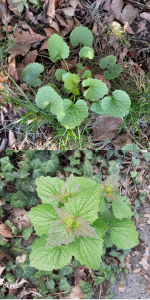
Garlic Mustard is an herbaceous plant in the mustard family. It emits a strong garlic smell when crushed. This plant was initially introduced as an herbal medicine plant in the late 1800s, but quickly spread out of control. Garlic Mustard seeds can be dropped directly from mature plants, or spread by humans, pets, and wildlife. Garlic Mustard self-pollinates, so a single plant can start an entire population. A single plant can produce upwards of 150 seed pods with 22 seeds per pod, and a population can produce over 100,000 seeds per square meter. Seeds usually remain dormant for a year and can remain viable in the soil for up to five years.
Garlic Mustard is biennial, meaning it has a two-stage life cycle. It begins life as a basal rosette that over-winters before growing into its second stage the following May, a tall flowering stalk that produces seeds in July and August. If this stalk is damaged, the plant can grow a new one as late as August.
This plant is unappetizing to native herbivore species, which puts more predation pressure on the native plant species herbivores prefer eating. Garlic Mustard can also grow well in undisturbed soil, which makes it a major threat in established forest communities. This plant competes with native spring ephemerals, a group of plants that already faces many challenges. The highly nutritious leaves of Garlic Mustard stimulate decomposition, which puts many native forest species (such as salamanders) at risk by reducing leaf litter depth. Finally, Garlic Mustard can prevent forest recovery by outcompeting native tree seedlings.
Expandable List
Removing Garlic Mustard on your property can be a great way to protect local forests.
- Prioritize small patches and isolated individuals to slow the spread.
- Hand-pulling is the most effective strategy available to most people but must be repeated multiple years to exhaust the seed bank in the soil.
- Removing Garlic Mustard in May and June (before it has started producing seeds) is the most effective strategy to prevent further spread.
- Replant native species in areas where invasive species have been removed to prevent other invasive species from taking over the area.
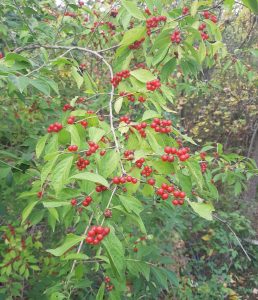
Invasive Honeysuckles (Lonicera spp.)
A number of non-native honeysuckle species and hybrids were introduced to Ontario as ornamental shrubs as far back as the 18th century. By 1920, these plants had escaped captivity and were widely abundant by the 1960s. These honeysuckle species reproduce primarily through seeds, which are eaten by birds and mammals and dispersed in their droppings. Invasive honeysuckles produce lots of berries, which remain on the plant well into the winter.
These honeysuckle species outcompete native shrubs by growing faster and larger (giving them more access to light and nutrients) and through their high seed production. They also grow well in disturbed habitat where native species struggle to get established. Through their rapid growth they form dense thickets, reducing species diversity and damaging ecosystems. They can grow both in forest edge and interior forest habitat, putting them in direct competition with many native species (including species at risk).
Expandable List
Invasive honeysuckles can take over large areas and spread quickly, so removing them is crucial to protecting native species.
Note: Ontario is home to a number of native honeysuckle species. Before removing honeysuckles, ensure you can distinguish the invasive honeysuckles from native species.
- Prioritize removing isolated seedlings and satellite populations to slow the spread.
- Shovels, weed wrenches, and hand pulling are all effective removal strategies, but must be repeated multiple times to exhaust the seed bank in the soil.
- When removing fruiting honeysuckles, dispose of berries carefully to prevent spread.
- Replant native species in areas where invasive species have been removed to prevent other invasive species from taking over the area.
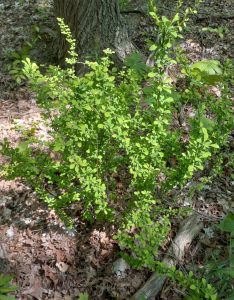
Japanese Barberry (Berberis thunbergii)
Japanese Barberry is a common ornamental shrub that was introduced to North America in the late 1800s and has remained popular in the horticulture trade. This plant spreads primarily through its bright red berries, which are eaten by birds and dispersed in their droppings. Additionally, broken branches and stems can grow roots and establish as a new plant if not properly disposed of, so yard waste dumping is another common way this plant spreads.
Japanese Barberry forms dense thickets and grow well in forest edge and forest interior habitat. The sharp thorns of this shrub make it unappetizing for most herbivores, which helps them outcompete native species. Recent research also suggests that tick populations are higher in areas where Japanese Barberry is prevalent, and that ticks in these areas are more likely to carry Lyme disease-causing bacteria.
Expandable List
The best way to prevent the spread of this invasive species is to avoid planting it in your garden and to spread awareness about its harmful impacts on the environment. However, if you have Japanese Barberry on your property, here are some tips for removing it:
- Hand-pulling is effective for small plants, but wear thick gloves to protect from their sharp thorns.
- Larger plants can be safely and effectively removed with shovels or weed wrenches.
- Replant native species in areas where invasive species have been removed to prevent other invasive species from taking over the area.
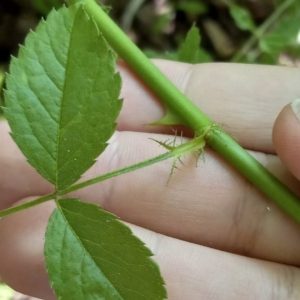
Multiflora Rose (Rosa multiflora)
Multiflora Rose is a shrubby rose species that grows in long, arching canes. Originally introduced to North America to prevent soil erosion and as an ornamental species, it quickly spread out of control. This species matures quickly and can reproduce both from seed and vegetatively. When a Multiflora Rose cane touches the ground, it can grow roots from the contact point and sprout a new plant. This species can be distinguished from other rose species by its fringed stipules (the flared area at the base of each leaf), and by its greater number of thorns, greater number of flowers, and larger size.
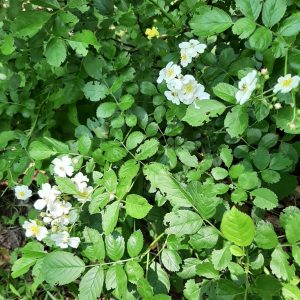
Multiflora Rose easily outcompetes native species in edge habitat and open areas through its quick growth and reproduction. The most common ways it eradicates other species is by shading them out or suffocating them under its dense foliage. When this species has taken over an area, it is often one of the only plant species growing there or is mixed with other invasive species.
Expandable List
While removing Multiflora Rose can be challenging, it is incredibly beneficial to local ecosystems and the results are rewarding.
- Prioritize individuals and satellite populations to slow the spread.
- Hand-pulling is effective for small plants and cutting followed by digging works for larger plants. Be sure to wear gloves and other protective equipment to avoid injury from thorns.
- Mulching in either the Winter or early Spring can be effective for controlling large populations.
- Replant native species in areas where invasive species have been removed to prevent other invasive species from taking over the area.
